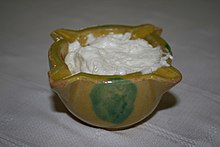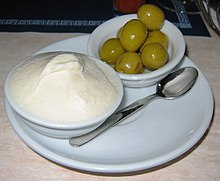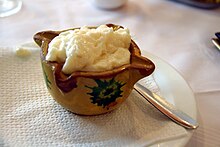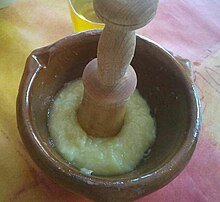Aioli
The alioli (from the Catalan allioli, which means 'garlic and oil'), ajolio or ajaceite (in Aragon), ajoaceite (in Spanish from the Valencian Community, Murcia and Albacete), ajiaceite or ajaceite is a typical gastronomy sauce Mediterranean formed by the emulsion of olive oil and garlic.
It is usually used as a seasoning in some dishes, especially in preparations based on fish or shellfish, sometimes as a sauce served separately. It is part of garlic-based sauces. It is frequent in regions and islands of the Mediterranean arc between Spain, France and Italy, such as Provence (where it is called Le Grand Aïoli) or Liguria. In certain areas of Africa, a very similar preparation called Toum is made. Among these dishes we can mention the universal arroz a banda and the caldero from Alicante and Murcia.
Origin
On the one hand, its origin would date back to Roman times, who would have obtained it from the Egyptians and spread it throughout Italy and Sicily. The Andalusians, in turn, would have taken it to the north, whose recipe is remains today, extending to Provence and the Balearic Islands. In its original version it consisted of a mashed garlic and olive oil blended to form a cream. There are even special ceramic mortars for this purpose.
Uses
It is customary to take it with fish (especially cod), with shellfish (squid, cuttlefish, prawns, etc.), with grilled meat, grilled or grilled vegetables, or roasted, fried or boiled potatoes. In Catalonia it is typical to eat it in local dishes such as butifarras with white beans or grilled rabbit with alioli. In Campo de Cartagena, the Valencian Community and Aragon it is also common to take it with some types of rice in paellas, especially those based on fish, such as arroz a banda, caldero, black rice, and fideuá. It is also used to accompany fried fish on the Costa del Sol. Chips covered in aioli sauce are one of the most popular tapas on the eastern Mediterranean coast. Sometimes the patatas bravas also have aioli. In the towns of Campo de Cartagena it is eaten with the traditional caldero and in Murcia with roasted potatoes. In Provence, the sauce gives its name to a dish that is prepared with cod, vegetables and aioli. In the French Basque Country, this sauce typically accompanies Roman squid.
Aioli is usually eaten cold or at room temperature, but it's not uncommon to use it to top foods that are later baked in the oven. For example, in Aragon a very typical dish is cod browned first a little in a pan and later covered in alioli and baked in the oven. Participate in some dishes with cod such as cod au gratin, cod ab burrida from the Balearic Islands, cod a la brandi coglioni and even Mediterranean brandade and Basque pil pil cod.
You can make the sauce with only garlic, salt and oil, although some find it difficult to bind (emulsify), and add an egg yolk at first.
Preparation
It is made with garlic and olive oil, as its name indicates. You have to crush the garlic a lot, to extract the juice, since that is what binds with the oil, and add the oil with an oil can, almost drop by drop so that it does not cut, while stirring with Mace. At first the taste and smell of garlic is very strong, more than garlic alone due to the fat provided by the oil, but little by little it is diluted. However, for a mortar of aioli two garlics are usually enough, although you can add one or two more for a stronger garlic flavor and a bit of heat. A little salt is added to the garlic at first. At the end you can add salt and, optionally, add a few drops of lemon juice as seasoning. Modernly the sauce can be assembled with a blender or other similar devices.
Garlic cloves can be removed from the inner sprouting stalk to avoid excessive aroma.
In the preparation, the lemon juice needs to be in contact with the crushed garlic for about three minutes to facilitate the blending process, or emulsion, with the virgin olive oil.
Variants
Negado aioli is an aioli in which the garlic is voluntarily not fully emulsified with the oil, giving it a more vinaigrette-like appearance. This aioli is widely used as a dressing or to add to more complex recipes for dishes, in which it is usually placed in a clay pot on the stove or in the oven.
You can also make quince aiolis (by adding a quince) or pear, for example. It is also not uncommon to make scented aiolis and mayonnaises with, for example, a chopped anchovy, or olives, or capers for variety and to better suit specific dishes or foods.
In Provence, in the southeast of France, the traditional recipe for aïoli (aïoli in French, aiòli in Provençal) is the same than the Spanish Currently, to facilitate its preparation, it usually has egg yolk and sometimes mashed boiled potato, although this last option is criticized by purists. Its texture is then more similar to a cod brandade, in which it is replaced by a little garlic, than to that of the classic aïoli from Provence. In the south of France, part of the shrimp shell is used to make the emulsion.
Controversy
According to some purists, the name aioli can be applied only to the emulsion of garlic and (olive) oil, which has no ingredients other than raw garlic, oil and salt. However, it is laborious to get the garlic to emulsify. In the Valencian Community, Murcia and Catalonia there are many restaurants that keep the recipe alive and also the homes that continue to "develop" it with great patience. On many occasions what is known as aioli does not apply to the original sauce but to to mayonnaise with added garlic, sometimes dehydrated and powdered. This is considered a sacrilege for people who know authentic aioli, whatever its origin; who prefer to call it "mayonnaise with garlic" or "ajonnaise" and consider it to be of a much lower quality, much more so if it comes to versions with oils. olives that are not extra virgin and even worse if products such as milk, potatoes or certain spices are added.
Contenido relacionado
Aniseed
TuKola
Okonomiyaki







